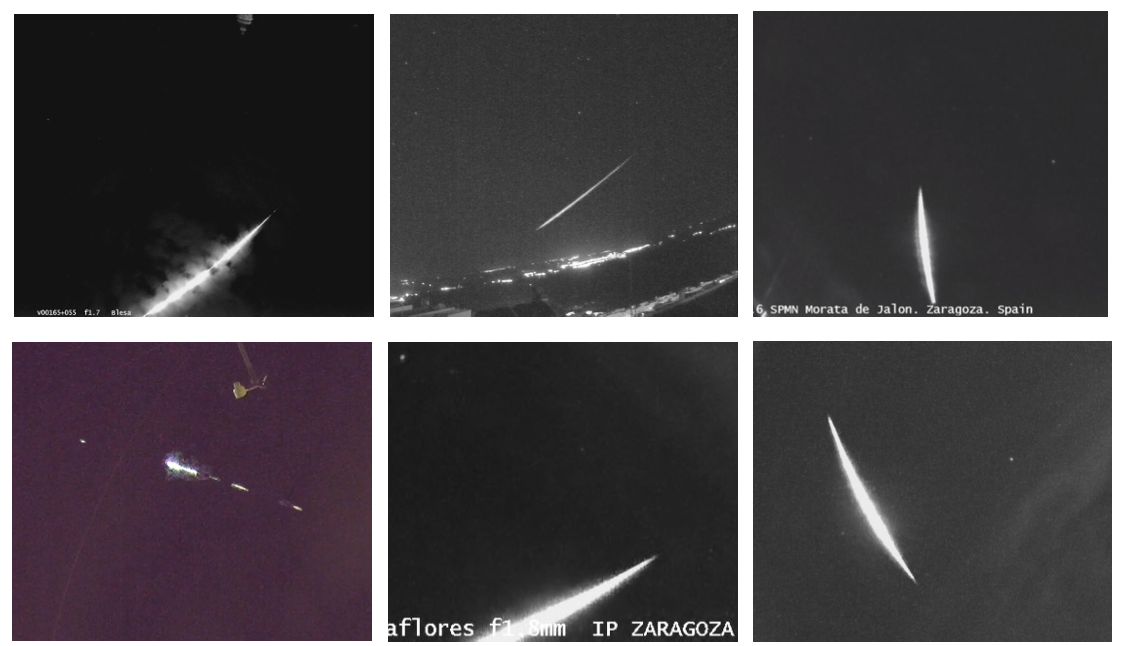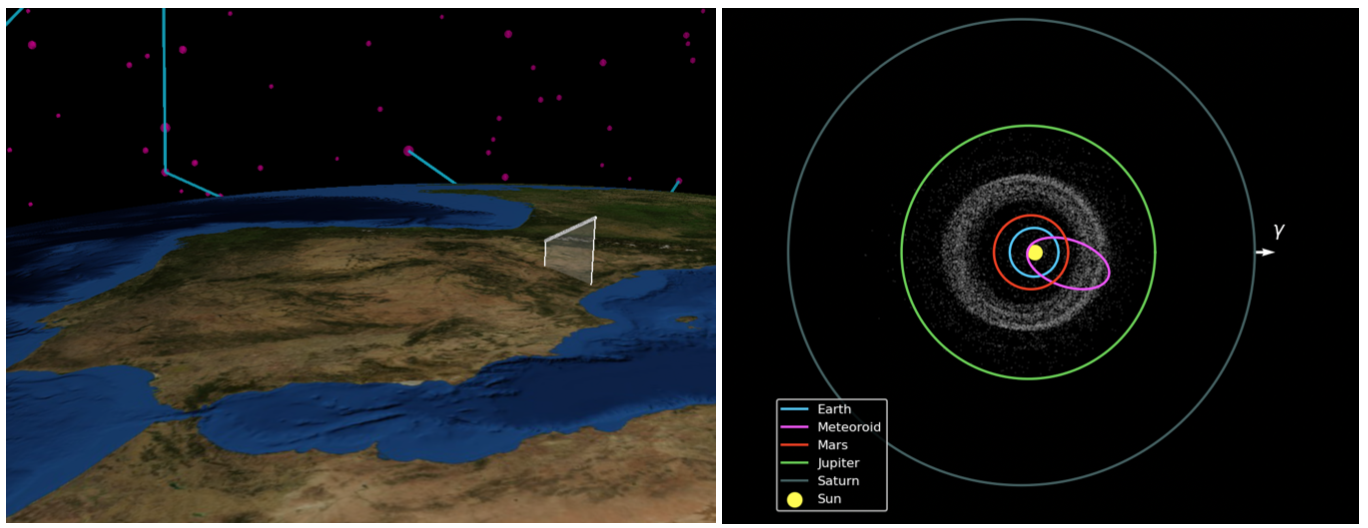New SPMN network software for fireball detection and analysis: the SPMN010521 bolide event
- 1Universitat Autònoma de Barcelona, Spain (eloy.pena@uab.cat)
- 2Universitat Autònoma de Barcelona (UAB), 08193 Cerdanyola del Vallès, Barcelona, Catalonia, Spain
- 3Institut d’Estudis Espacials de Catalunya (IEEC), Gran Capità 2-4, Ed. Nexus, desp. 201, 08034 Barcelona, Catalonia, Spain
- 4Finnish Geospatial Research Institute (FGI), Geodeetinrinne 2, FI-02430 Masala, Finland
- 5Universidad Complutense de Madrid (UCM), Avda. de Séneca, 2, Ciudad Universitaria, 28040, Madrid, Spain
- 6Observatorio Astrofísico de Javalambre (CEFCA), Arcos de las Salinas, 44421, Teruel, Spain
- 7Agrupación Actuel
- 8Spanish Meteor Network (SPMN)
- Introduction
In Spain, the Spanish Meteor Network (SPMN) has been operating for 25 years, recording meteoric events and re-entries over the Iberian Peninsula, Morocco, and the insular territory [1]. This is a pro-am project involving a scientific team specialized in areas such as astronomy, geology, geophysics, and chemistry.
Obtaining the trajectory of meteoroids impacting the atmosphere is crucial both for the recovery of possible meteorites and for studying their origin in the Solar System. Some of these objects can be dynamically associated with their parent bodies, being part of meteoroid streams [2]. Herein lies the importance of monitoring the sky constantly and completely from multiple monitoring stations. The SPMN network has 34 stations equipped with all-sky cameras or wide-angle lenses, and we recently upgraded the software to reduce the ever-increasing amount of data. Here we present our automated Python (called 3D-FireTOC) pipeline for meteor detection from digital systems, astrometric measurements, photometry, atmospheric trajectory reconstruction and heliocentric orbit computation, all in all quantifying the error measurements in each step [3].
- Analytical procedures of the 3D-FireTOC software
A key step to achieve proper reduction is the development of automated astrometry to ensure the measurement of meteors appearing in the field of view of video-detection systems. To do this, we use computer vision techniques to obtain the pixel coordinates corresponding to the moving meteor in each frame. Each image is processed and compared with a reference image (without detection) allowing us to extract the pixels that have been activated by the meteor. In this way, the centroid of the detected pixel area corresponds to the position in the image of the meteoroid (see Figure 1).
Due to the changing nature of this type of recordings as well as possible light reflections and obstacles in the field of view, we have implemented three methods to avoid false positives: 1) discriminating by the size of the detected area excluding excessively small and large contours, 2) predicting the next position of the meteor with a Kalman filter, and 3) post-processing the detected points and applying clustering algorithms to check if the trajectory is consistent with a more or less straight line. Figure 2 shows an example of false positive avoidance.
To transform the pixels into real coordinates is necessary to identify stars in the image to obtain their position in the sky for the date of the event. To do this, we use corner detection algorithms since the stars appear randomly distributed in the sky and far from each other. Again, we use clustering algorithms but this time selecting the points identified as noise, as can be seen in Figure 2.
Once the stars have been identified, thanks to JPL's Horizons ephemerides, we can model the deformation produced by the lens by finding the correspondence between pixel and real position. In particular, we apply a polynomial variant [4] of the method proposed by [5] for all-sky camera astrometry.

Fig.1

Fig. 2
The result we obtain from each observation is an apparent trajectory projected on the celestial sphere. Naturally, two or more observations sufficiently far apart are required to triangulate the real position of the meteoroid. Because these fragments reach the Earth at very high velocities, air resistance practically does not bend their trajectories so that they can approximate a straight line. This allows the plane intersection method to be applied to reconstruct the atmospheric flight [6]. Finally, the trajectory is projected backwards to obtain the radiant, i.e. the position of origin in the sky. From the atmospheric flight, the α-β criterion can be applied approximating the chances that the event produced meteorites [7,8].
- Recent example: SPM010521 event
On May 1, 2021, a bolide flew over Aragón reaching a magnitude of -11. It was recorded by 6 stations of the SPMN network (Table 1 and Figure 3). The luminous phase started at 107 km altitude and ended at 43 km. The flight angle with respect to the horizontal was 24º degrees. With a geocentric velocity of 30 km/s, its orbital parameters indicate a possible association with a IAU working list of meteor showers called Southern May Ophiuchids. Unfortunately, it was not a meteorite-dropper event as reveals the α-β criterion result: α=315.4, β=1.2, an estimated initial mass of 0.1 kg and an estimated final mass less than one gram. Figure 4 shows the 3D representation and scale of the reconstructed atmospheric trajectory, as well as the calculated heliocentric orbit.

Fig. 3

Fig. 4
- Conclusions
With the implementation of this new software, the SPMN increases its capacity to rapidly generate new knowledge about the origin of large meteoroids, and their capacity to generate hazard. Multi-station analyses also provide valuable information about their bulk physical properties and, from their heliocentric orbits, the dynamic association with comets, asteroids, or even planetary bodies can be inferred [3]. In addition, the automation of the meteor detection and the entire analysis process allows immediate preparation of meteorite search campaigns. Our software developments will be soon applied to increase our close cooperation with FRIPON [9].
As an example of application, we present the results obtained on SPMN010521, a recent fireball recorded and analyzed by the SPMN, which did not produce meteorites and seems to be dynamically associated with an unestablished meteor shower.
Acknowledgements
This research has been funded by the research project PGC2018-097374-B-I00, (MCI-AEI-FEDER, UE). Funding from the European Research Council (ERC) under the European Union’s Horizon 2020 research and innovation programme for the project “Quantum Chemistry on Interstellar Grains” (QUANTUMGRAIN, grant agreement No. 865657) is acknowledged.
References
- [1] Trigo-Rodríguez J.M. et al. (2006) Astronomy & Geophysics 47, 6.26
- [2] Hughes, D. W.(1990) MNRAS 245, 198-203.
- [3] Peña-Asensio, E., Trigo-Rodríguez, J. M., Gritsevich, M., & Rimola, A. (2021) MNRAS 504(4), 4829-4840.
- [4] Bannister, S. M., Boucheron, L. E., & Voelz, D. G. (2013) ASP125(931), 1108.
- [5] Borovička, J. (1992) AICAS, 79.
- [6] Ceplecha, Z. (1987) BAIC, 38, 222-234.
- [7] Gritsevich M., 2009, Advances in Space Research, 44, 323.
- [8] Sansom E. K., et al., 2019, The Astrophysical Journal, 885, 115.
- [9] Colas, F. et al. (2020) Astronomy & Astrophysics 644, id.A53, 23 pp.
How to cite: Peña-Asensio, E., Trigo-Rodríguez, J. M., Gritsevich, M., Rimola, A., Izquierdo, J., Zamorana, J., Chioare-Díaz, M., Iglesias-Marzoa, R., Milian Biel, J., Ibañez, V., Robles, A. J., Pastor, S., de los Reyes, J. A., Guasch, C., Aznar Carbó, M., and Lasala, A.: New SPMN network software for fireball detection and analysis: the SPMN010521 bolide event, European Planetary Science Congress 2021, online, 13–24 Sep 2021, EPSC2021-738, https://doi.org/10.5194/epsc2021-738, 2021.

